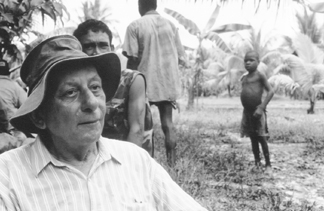People: It's What For Dinner
In search of inner peace, one New Yorker learns that people taste like pork in 'Keep The River On Your Right: A Modern Cannibal's Tale'
By Bobby Houlihan

In 1955, Tobias Schneebaum, a well respected New York painter, was reported missing in the Amazonian jungle of Peru. Nearly eight months later, presumably dead, Schneebaum walked out of the jungle, naked and covered in body paint. His story, Keep the River on Your Right is a modern tale of tourism, cannibalism, sexuality and one man's search for inner peace.
"I don't know if I accepted the jungle, or if the jungle accepted me. I suppose it doesn't matter," Schneebaum has said about the experience.
It was in the early 90s that documentary film maker David Shapiro, a well-known director of short films, and his sister, Laurie Gwen Shapiro, a comic novelist (The Unexpected Salami) came upon Schneebaum's story. The Shapiros were walking through the streets of New York when they found a box of books in a heap of garbage, among them was a book unfamiliar to them both, Keep the River On Your Right, a book that Schneebaum had written after his experience in Peru. Inspired, the Shapiros took little time in deciding to collaborate and make a film of these amazing events. Five years passed and the Shapiros found themselves sitting next to Schneebaum in a hand-carved canoe upriver in Asmat, New Guinea.
This filmed examination of Schneebaum's adventure begins post-Peru in the mid-1990s in New York City where he presently lectures about primitive art and culture. An opening sequence shows him speaking to a group of Barnard students, calmly answering a number of inquiries about his cannibal experiences.
The documentary follows Schneebaum as he takes a group of tourists to a small Indonesian island where they happen upon a ritual circumcision. Images of Westerners videotaping a small boy as he beseeches them with looks of fear and confusion precede a brief interview in which Schneebaum eyes the camera with disgust and explains that he does not like tourism, but it's how he makes his money.
Shortly after, Schneebaum and the Shapiro film crew travel by a small boat to the remote interior of Asmat, New Guinea where he has not been in a number of years. It was here that famed archeologist Michael Rockefeller disappeared in the sixties and is presumed to have been killed and eaten by cannibals. It was at about the same time in the sixties that Schneebaum moved to the interior of Asmat and was taken in by the tribe.
One native who remembered Schneebaum explained that he was happy to have him back. "Tourists come to Asmat to look and then they leave. Tobias came back."
After a few days in Asmat, Schneebaum and the film crew run into Aipit, Schneebaum's old friend and former lover, a man thought to be dead. This emotional reunion lasts only a few days as the crew must return to New York, though it does manage to serve as one of the film's more authentic insights into Schneebaum's person and his questions regarding homosexuality.
A ride on the subway to New York's Coney Island begins the last segment of the film, introducing Schneebaum's earliest interests in primitive culture.
As a young boy, Schneebaums' mother would often take him and his brothers to Coney Island. It was here that he encountered the Wild Man of Borneo, a side show attraction of a primitive looking man in a cage.
"I can always remember lusting after the Wild Man of Borneo," recalls a reminiscent Schneebaum.
Arriving at Coney Island, he promptly buys and eats a famous "coney dog." At this point, the audience cannot help but recall the footage shown earlier in the film where Schneebaum explains that, "People taste like pork."
Schneebaum left Peru after unwillingly participating in a tribal raid that resulted in murder and cannibalism. On the evening in question, he believed that the tribe was going on a routine animal hunt and was shocked when the men waited until late into the night, painted themselves from head to toe with war paint and then raided a neighboring tribe, killing and eating its members. Although he claims that he did not participate in the actual murders, he admits to eating several of the victims. Understandably, this experience motivated him to return home even though he had still not found the inner peace that originally drove him to this region of the world.
When Schneebaum entered the jungles of Peru in 1955, he was searching for a connection to something larger than what he could find on the streets of New York. He was able to find comfort, though no answers, in primitive culture.
Now Schneebaum lives in a small apartment in New York City and is presently a tour guide on a cruise ship. He happily turned 80 years old in March of this year. Keep the River on the Right offers a uniqe chronicle of Schneebaum's journey as he revisits the events of his past on film. Forty-five years after the fact, this documentary succeeds in showing the impact of one man's search for peace, uncertain whether he chose the jungle or the jungle chose him.
HOME | THIS ISSUE | ACE ARCHIVES